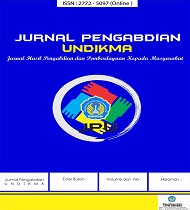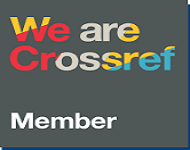Development of Critical Thinking Skills Instruments : Cases for Essay Tests
DOI:
https://doi.org/10.33394/jk.v10i1.10052Keywords:
Critical Thinking, Rubric, Assessment.Abstract
References
Abrami, P. C., Bernard, R. M., Borokhovski, E., Waddington, D. I., Wade, C. A., & Persson, T. (2014). Strategies for Teaching Students to Think Critically: A Meta-Analysis. Review of Educational Research, 1–40. https://doi.org/10.3102/0034654314551063
Anderson, T., & Soden, R. (2001). Peer interaction and the learning of critical thinking skills. Psychology Learning & Teaching, 1(1), 37–40.
Bezanilla, M. J., Fernández-Nogueira, D., Poblete, M., & Galindo-DomÃnguez, H. (2019). Methodologies for teaching-learning critical thinking in higher education: The teacher’s view. Thinking Skills and Creativity, 33(100584), 1–10. https://doi.org/10.1016/j.tsc.2019.100584
Biggs, J. (2014). Constructive alignment in university teaching. HERDSA Review of Higher Education, 1(1), 5–22.
Brookhart, S. M., & Chen, F. (2015). The quality and effectiveness of descriptive rubrics. Educational Review, 67(3), 343–368. https://doi.org/10.1080/00131911.2014.929565
Butler, H. A. (2012). Halpern Critical Thinking Assessment Predicts Real-World Outcomes of Critical Thinking. Applied Cognitive Psychology, 26(5), 721–729. https://doi.org/10.1002/acp.2851
Button, C. M., Snook, B., & Grant, M. J. (2020). Inter-Rater Agreement, Data Reliability, and The Crisis of Con fi dence in Psychological Research. Quant Methods Psychol, 16(5), 467–471.
Cooke, N. A. (2017). Posttruth, Truthiness, and Alternative Facts: Information Behavior and Critical Information Consumption for a New Age. The Library Quarterly, 87(3), 211–221. https://doi.org/10.1086/692298
Cooper, K. M., & Brownell, S. (2020). Student Anxiety and Fear of Negative Evaluation in Active Learning Science Classrooms Chapter 56 Student anxiety and fear of negative evaluation in active learning science classrooms. February. https://doi.org/10.1007/978-3-030-33600-4
Din, M. (2020). Evaluating university students’ critical thinking ability as re fl ected in their critical reading skill : A study at bachelor level in Pakistan. Thinking Skills and Creativity, 35(100627), 1–11. https://doi.org/10.1016/j.tsc.2020.100627
Ennis, R. H. (2011). The Nature of Critical Thinking: An Outline of Critical Thinking Dispositions. 1–8. http://faculty.education.illinois.edurhennis/documents. TheNatureofCriticalThinking_51711_000.pdf
Facione, P. A. (2000). The Disposition Toward Critical Thinking: Its Character, Measurement, and Relationship to Critical Thinking Skill. Informal Logic, 20(1), 61–84.
Golter, P., Brown, G., & Wie, B. Van. (2016). Preliminary Validation of a Critical Thinking Rubric for Fluid Mechanics and Heat Transfer. Journal of STEM Education, 17(4), 19–28.
Gray, K., & Koncz, A. (2018). The key attributes employers seek on students’ resumes. http://www.naceweb.org/about-us/press/2017/the- key-attributes-employers-seek-on-students-resumes/
Halpern, D. F. (2010). Halpern Critical Thinking Assessment. SCHUHFRIED. http://www.schuhfried.com/vienna-test-system-vts/all-tests-from-a-z/test/hcta-halpern-critical-thinking-assessment-1/
Hart, C., Da, C., Souza, D. D., Kimpton, A., & Ljbusic, J. (2021). Exploring higher education students’ critical thinking skills through content analysis. Thinking Skills and Creativity, 41(100877), 1–9. https://doi.org/10.1016/j.tsc.2021.100877
Hattie, J., & Gan, M. (2011). Instruction based on feedback. Handbook of research on learning and instruction.
Kholid, M. N., Hamida, P. S., Pradana, L. N., & Maharani, S. (2020). Students’ Critical Thinking Depends On Their Cognitive Style. International Journal of Scientific & Technology Research, 9(01), 1045–1049.
Khonamri, F., & Karimabadi, M. (2015). Collaborative Strategic Reading and Critical Reading Ability of Intermediate Iranian Learners. Theory and Practice in Language Studies, 5(7), 1375–1382. http://dx.doi.org/10.17507/tpls.0507.09
Kong, L.-N., Qin, B., Zhou, Y., Mou, S., & Gao, H.-M. (2014). The effectiveness of problem-based learning on development of nursing students’ critical thinking: A systematic review and meta-analysis. International Journal of Nursing Studies, 51, 458–469. https://doi.org/10.1016/j.ijnurstu.2013.06.009
Ku, K. Y. L., Kong, Q., Song, Y., Deng, L., Kang, Y., & Hu, A. (2019). What predicts adolescents’ critical thinking about real-life news? The roles of social media news consumption and news media literacy. Thinking Skills and Creativity, 33(100570), 1–12. https://doi.org/10.1016/j.tsc.2019.05.004
Kuhn, D. (2019). Critical Thinking as Discourse. Human Development, 62(3), 146–164. https://doi.org/10.1159/000500171
Lai, E. R. (2011). Critical Thinking: A Literature Review. Pearson’s Research Reports, 6(1), 1–49. https://doi.org/10.1046/j.1537-2995.1995.35395184278.x
Lin, S. (2013). Science and non-science undergraduate students’ critical thinking and argumentation performance in reading a science news report. International Journal of Science and Mathematics Education, 12(5), 1023–1046. https://doi.org/10.1007/s10763-013-9451-7
Liu, O. L., Frankel, L., & Roohr, K. C. (2014). Assessing Critical Thinking in Higher Education: Current State and Directions for Next-Generation Assessment. ETS Research Report Series, 1, 1–23.
Pearl, A. O., Rayner, G. M., Larson, I., & Orlando, L. (2018). Thinking about critical thinking: An industry perspective. Industry and Higher Education, 1–11. https://doi.org/10.1177/0950422218796099
Pui, P., Yuen, B., & Goh, H. (2020). Using a Criterion-referenced Rubric to Enhance Student Learning: a case study in a critical thinking and writing module. Higher Education Research & Development. https://doi.org/10.1080/07294360.2020.1795811
Reynders, G., Lantz, J., Ruder, S. M., Stanford, C. L., & Cole, R. S. (2020). Rubrics to assess critical thinking and information processing in undergraduate STEM courses. International Journal of STEM Education Https://Doi.Org/10.1186/S40594-020-00208-5, 7(9), 1–15. https://doi.org/10.1186/s40594-020-00208-5
Saxton, E., Belanger, S., & Becker, W. (2012). The Critical Thinking Analytic Rubric (CTAR): Investigating intra-rater and inter-rater reliability of a scoring mechanism for critical thinking performance assessments. Assessing Writing, 17, 251–270.
Shaw, A., Liu, O. L., Gu, L., Kardonova, E., Chirikov, I., Li, G., Hu, S., Yu, N., Ma, L., Guo, F., Su, Q., Shi, J., & Loyalka, P. (2019). Thinking critically about critical thinking: validating the Russian HEIghten ® critical thinking assessment. Studies in Higher Education, 2–16. https://doi.org/10.1080/03075079.2019.1672640
Smit, R., & Birri, T. (2014). Assuring the quality of standards-oriented classroom assessment with rubrics for complex competencies. Studies in Educational Evaluation, 1–9. https://doi.org/10.1016/j.stueduc.2014.02.002
Stein, B., & Haynes, A. (2011). Engaging Faculty in the Assessment and Improvement of Students’ Critical Thinking Using the Critical Thinking Assessment Test By Barry Stein and Ada Haynes. Change: The Magazine of Higher Learning, 43(2), 44–49.
Tong, F., Tang, S., Irby, B. J., Lara-alecio, R., & Guerrero, C. (2020). The determination of appropriate coe ffi cient indices for inter-rater reliability : Using classroom observation instruments as fi delity measures in large-scale randomized research. International Journal of Educational Research, 99(101514), 1–10. https://doi.org/10.1016/j.ijer.2019.101514
Undergraduate Professional Education in Chemistry ACS Guidelines and Evaluation Procedures for Bachelor’s Degree Programs. (2015). American Chemical Society Committee on Professional Training.
VALUE Rubric Development Project. (2019). Association of American Colleges and Universities. https://www.aacu.org/value/rubrics
Vision for science and mathematics education. (2014). The Royal Society Science Policy Centre.
Wale, B. D., & Bishaw, K. S. (2020). Effects of using inquiry-based learning on EFL students’ critical thinking skills. Asian-Pacific Journal of Second and Foreign Language Education, 5(9), 1–14.
Downloads
Published
How to Cite
Issue
Section
Citation Check
License
License and Publishing Agreement
In submitting the manuscript to the journal, the authors certify that:
- They are authorized by their co-authors to enter into these arrangements.
- The work described has not been formally published before, except in the form of an abstract or as part of a published lecture, review, thesis, or overlay journal.
- That it is not under consideration for publication elsewhere,
- That its publication has been approved by all the author(s) and by the responsible authorities tacitly or explicitly of the institutes where the work has been carried out.
- They secure the right to reproduce any material that has already been published or copyrighted elsewhere.
- They agree to the following license and publishing agreement.
Copyright
Authors who publish with JK agree to the following terms:
- Authors retain copyright and grant the journal right of first publication with the work simultaneously licensed under a Creative Commons Attribution License (CC BY-SA 4.0) that allows others to share the work with an acknowledgment of the work's authorship and initial publication in this journal.
- Authors are able to enter into separate, additional contractual arrangements for the non-exclusive distribution of the journal's published version of the work (e.g., post it to an institutional repository or publish it in a book), with an acknowledgment of its initial publication in this journal.
- Authors are permitted and encouraged to post their work online (e.g., in institutional repositories or on their website) prior to and during the submission process, as it can lead to productive exchanges, as well as earlier and greater citation of published work.
Licensing for Data Publication
-
Open Data Commons Attribution License, http://www.opendatacommons.org/licenses/by/1.0/ (default)

This work is licensed under a Creative Commons Attribution-ShareAlike 4.0 International License.







